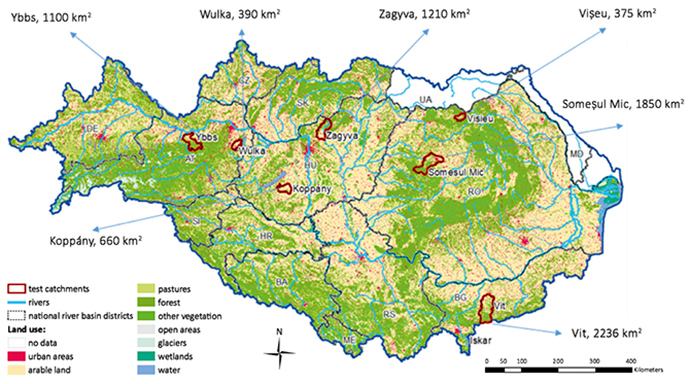Danube Watch 3/2021 - Danube Hazard m³c
Danube Hazard m3c
Towards transnational control and reduction of hazardous substances water pollution in the Danube River Basin

What’s the problem?
Human activities provoke the emission of hundreds of thousands of chemicals into the environment. Many of these substances are persistent, ubiquitous and bioaccumulative, and even at very low concentration levels their presence in water bodies can pose a risk to human and environmental health. In contrast to, e.g., nutrients, knowledge on hazardous substances in the Danube River Basin is very poor and fragmented, especially with respect to the identification and quantification of the pathways of emissions into water bodies. Without a good systemic understanding, it is not possible to design efficient management strategies, let alone harmonize their management beyond national borders. Based on these premises, the Danube Transnational Programme funded the Danube Hazard m3c project with the main objective of paving the path for a durable and effective transnational control and reduction of hazardous substances water pollution in the basin. The project started in July 2020 and will end in December 2022.
What’s being done?
The project builds on the three elements of water governance: Measuring, Modelling and Management, accompanied by Capacity building.
Measuring: Key to better understanding the current levels of water pollution by hazardous substances, and the relevance of different emission pathways in the basin, is to merge the fragmented and dispersed available information into a database on concentration of hazardous substances in rivers, soils, wastewater treatment effluents and groundwater for all partners’ countries. Besides the great value of the collected data and of their evaluation, the project is showcasing the development of a much-needed integrated, well-documented and harmonized inventory across compartments, which is the essential basis for any modelling activity and evidence-based decision process. The database will be made available for the Danube countries so that they can make use of the collected information at national level.
Secondly, it’s vital to get out in the field and monitor the concentration of hazardous substances in different environmental compartments, to close critical gaps. Within the project, cost-efficient and integrated monitoring approaches are being tested in seven very different pilot regions across the basin. These are: Ybbs and Wulka (AT), Zagyva and Koppány (HU), Vișeu and Someșul Mic (RO), Vit (BG). Bearing in mind the large number of chemicals present in the environment, the project is focusing on 17 target substances of high relevance in the Danube River Basin and representative for different major sources and emission pathways.
Modelling: Two complementary modelling approaches are used in the project. The MoRE model (Modelling of Regionalized Emissions) is being applied to the seven pilot regions to quantify emission loads into surface waters via point and diffuse pathways. Building on the increased system understanding generated via this detailed analysis, the Danube Hazardous Substances Model (DHSM, an adapted version of the model developed in the SOLUTIONS project) is applied to model sources and emissions of hazardous substances for the whole Danube River Basin. Based on the preliminary results of the DHSM, the project’s team was able to contribute to the development of the Danube River Basin Management Plan Update 2021, recently published by the ICPDR. The model results are being updated based on the experiences in the pilot regions and on the latest available data to provide as accurate as possible information on the emission patterns within the Danube River Basin.
Management: Every task in the project was conceived with management in mind. Both models are being used not only to assess the status quo and provide a better system understanding, but also to test the effectiveness of different management measures by means of scenario analysis. A critical review of policies and management structures related to hazardous substances water pollution has identified the most pressing gaps and inconsistencies across countries, which are expected to hinder an effective and coordinated transnational handling. The monitoring and inventorying activities aim to better channel national resources into cost-effective methods and tools to gather most needed information out of constrained available budgets. Finally, the results obtained and the lessons learned during the lifetime of the project will be used to derive policy recommendations and technical guidance.
Capacity building: To turn the project’s vision into a reality and to achieve long-term changes in hazardous substances management, a tailor-made program of trainings and workshops, guided by the train-the-trainer principle, will transfer know-how and trigger constructive discussions among the different players in the field of water quality management across the basin.
Pilot regions
Seven pilot catchments, which were selected to cover differences and significant natural and anthropogenic aspects of the DRB for implementation of the targeted monitoring campaigns.

Who’s behind Danube Hazard m3c?
The Institute for Water Quality and Resource Management of the TU Wien (AT) leads a consortium which brings together the expertise and perspective of scientific institutions, technical agencies and governmental bodies. Monitoring and inventorying activities are coordinated by the Budapest University of Technology and Economics. The Environment Agency Austria leads the modelling in pilot regions, whereas the ICPDR coordinates the modelling activities at basin scale in collaboration with Deltares and the policy review together with the Bulgarian Water Association. The coordination of capacity building activities lies in the hands of National Administration “Romanian Waters”. Jozef Stefan Institute (SI), University of Zagreb, Water Research Institute (SK), Center for Ecotoxicological Research Podgorica (ME) and Institute of Chemistry (MD) complete the partnership. In addition, the project counts on the support of 13 associate strategic partners, which allow covering all basin countries and which strengthen the focus on management related aspects. Moreover, the project progress and results are regularly presented to the ICPDR at both technical (Pressures and Measures Expert Group) and policy-making level (Heads of Delegations).
Upcoming events
Austria, Bulgaria, Croatia, Hungary, Montenegro, Moldova, Romania, Slovakia, Slovenia
June - September 2022
Budapest, Bucharest and Vienna
September 2022
Vienna
November 2022







